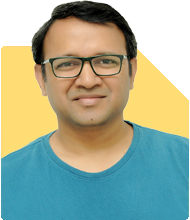Ramalingam Kalirajan |10894 Answers |Ask -Follow
Mutual Funds, Financial Planning Expert - Answered on Jul 12, 2024
He has an MBA in finance from the University of Madras and is a certified financial planner.
He is the director and chief financial planner at Holistic Investment, a Chennai-based firm that offers financial planning and wealth management advice.... more

I am 39 years old IT employee , I have monthly income of 3.5 lakhs and have a 10 years old son and wife .I have 35 lakhs in PF and 8 lakhs in ppf ,All I invested is in real estate and no other investments also i have 48 lakhs lakh an remaining for a house ,Where should I invest of I need to lan retirement by 50 will need 1.5 lakhs income per month post that
Assessing Current Financial Situation
You have a solid monthly income of Rs. 3.5 lakhs. This is a good start.
You have Rs. 35 lakhs in your Provident Fund (PF) and Rs. 8 lakhs in your Public Provident Fund (PPF). These are excellent long-term savings.
You have invested Rs. 48 lakhs in real estate. However, real estate alone may not be enough for retirement. Diversifying your portfolio is crucial.
Understanding the Importance of Diversification
Diversification is key to minimizing risk and maximizing returns. Currently, your investments are concentrated in real estate. You should consider diversifying into different asset classes.
Building a Balanced Investment Portfolio
1. Equity Mutual Funds:
Equity mutual funds can provide high returns over the long term. They are suitable for your retirement goal, which is more than a decade away.
Consider allocating a portion of your funds to diversified equity mutual funds. These funds invest in a mix of large-cap, mid-cap, and small-cap stocks, providing a balanced exposure to the equity market.
2. Debt Mutual Funds:
Debt mutual funds are less risky compared to equity funds. They provide stable returns and can be used to balance the risk in your portfolio.
Investing in debt funds will ensure that a portion of your investments remains safe, while still earning moderate returns.
3. Public Provident Fund (PPF):
Your current PPF investment is Rs. 8 lakhs. Continue contributing to PPF as it offers tax benefits and guaranteed returns. It’s a safe investment for long-term financial goals.
4. Provident Fund (PF):
With Rs. 35 lakhs in PF, you already have a significant amount saved. Ensure you continue contributing to this fund, as it provides a reliable source of retirement income.
Exploring the Benefits of Actively Managed Funds
Actively managed funds, run by experienced fund managers, can potentially outperform the market. These funds require active monitoring and adjustment, which can lead to better returns compared to passive index funds.
Disadvantages of Index Funds:
Index funds follow the market index, and they do not aim to outperform it. This means during market downturns, index funds will also suffer. They lack the flexibility to adjust holdings based on market conditions.
Benefits of Actively Managed Funds:
Actively managed funds have the potential to generate higher returns. Fund managers can make strategic decisions based on market trends and economic conditions. They can also provide a more tailored investment approach.
Considering the Role of Certified Financial Planners
Investing through a Certified Financial Planner (CFP) can offer several advantages. They provide personalized advice and help create a financial plan tailored to your goals.
Disadvantages of Direct Funds:
Investing directly without professional guidance can be risky. You might miss out on strategic opportunities and fail to manage risk effectively. A CFP can help optimize your investment strategy.
Benefits of Regular Funds through CFP:
Investing through regular funds with the help of a CFP ensures you receive expert advice. They can help you navigate market complexities and make informed decisions. This professional guidance can lead to better financial outcomes.
Creating a Retirement Corpus
To achieve your retirement goal of Rs. 1.5 lakhs monthly income post-retirement, you need to build a substantial corpus. Given your current assets and income, a disciplined investment approach is essential.
1. Setting Clear Goals:
Define how much you need at retirement. This will help you understand how much to save and invest each month.
2. Regular Investments:
Invest regularly in mutual funds through Systematic Investment Plans (SIPs). SIPs help in averaging out market volatility and build a corpus over time.
3. Reviewing and Rebalancing:
Regularly review your investment portfolio. Rebalance it to ensure it aligns with your goals and risk tolerance. This involves shifting funds between asset classes based on market performance and your investment horizon.
Importance of Emergency Fund
Maintain an emergency fund to cover unforeseen expenses. This fund should cover at least six months' worth of expenses. It ensures you don't have to dip into your long-term investments in case of emergencies.
Managing Insurance Needs
Ensure you have adequate insurance coverage. Life insurance protects your family in case of any unfortunate event. Health insurance covers medical expenses, preventing financial strain.
Planning for Your Child's Future
Your 10-year-old son's education and future needs should also be planned for. Consider investing in child-specific mutual funds or creating a dedicated investment plan for his higher education and other needs.
Evaluating Current Investments
Real Estate:
While real estate can provide good returns, it's not very liquid. Consider the rental income potential and capital appreciation of your property.
Provident Fund (PF) and Public Provident Fund (PPF):
These are secure investments with tax benefits. Continue contributing to these funds for long-term stability.
Achieving Financial Independence
To achieve financial independence by 50, you need a comprehensive financial plan. This involves:
1. Increasing Savings:
Try to save and invest a significant portion of your income. Aim to save at least 30-40% of your monthly income.
2. Reducing Debt:
Avoid taking on new debt. Pay off any existing loans to reduce financial burden.
3. Enhancing Income:
Explore ways to increase your income. This could be through promotions, bonuses, or side gigs.
Final Insights
Reaching your retirement goal by 50 is achievable with disciplined planning and strategic investments. Diversify your portfolio, invest in equity and debt mutual funds, and continue contributing to PF and PPF. Seek guidance from a Certified Financial Planner to optimize your investments and ensure a secure financial future.
Best Regards,
K. Ramalingam, MBA, CFP
Chief Financial Planner,
www.holisticinvestment.in
You may like to see similar questions and answers below
Ramalingam Kalirajan |10894 Answers |Ask -Follow
Mutual Funds, Financial Planning Expert - Answered on Jun 28, 2024
Milind Vadjikar | Answer |Ask -Follow
Insurance, Stocks, MF, PF Expert - Answered on Sep 24, 2024
Ramalingam Kalirajan |10894 Answers |Ask -Follow
Mutual Funds, Financial Planning Expert - Answered on Jun 05, 2025
Ramalingam Kalirajan |10894 Answers |Ask -Follow
Mutual Funds, Financial Planning Expert - Answered on Jul 30, 2025
Patrick Dsouza |1429 Answers |Ask -Follow
CAT, XAT, CMAT, CET Expert - Answered on Dec 16, 2025
Nayagam P P |10858 Answers |Ask -Follow
Career Counsellor - Answered on Dec 16, 2025
Nayagam P P |10858 Answers |Ask -Follow
Career Counsellor - Answered on Dec 16, 2025
Samraat Jadhav |2510 Answers |Ask -Follow
Stock Market Expert - Answered on Dec 16, 2025
Samraat Jadhav |2510 Answers |Ask -Follow
Stock Market Expert - Answered on Dec 16, 2025
Nayagam P P |10858 Answers |Ask -Follow
Career Counsellor - Answered on Dec 16, 2025
Nayagam P P |10858 Answers |Ask -Follow
Career Counsellor - Answered on Dec 16, 2025
Ramalingam Kalirajan |10894 Answers |Ask -Follow
Mutual Funds, Financial Planning Expert - Answered on Dec 16, 2025
Nitin Narkhede |113 Answers |Ask -Follow
MF, PF Expert - Answered on Dec 15, 2025
Nitin Narkhede |113 Answers |Ask -Follow
MF, PF Expert - Answered on Dec 15, 2025

























